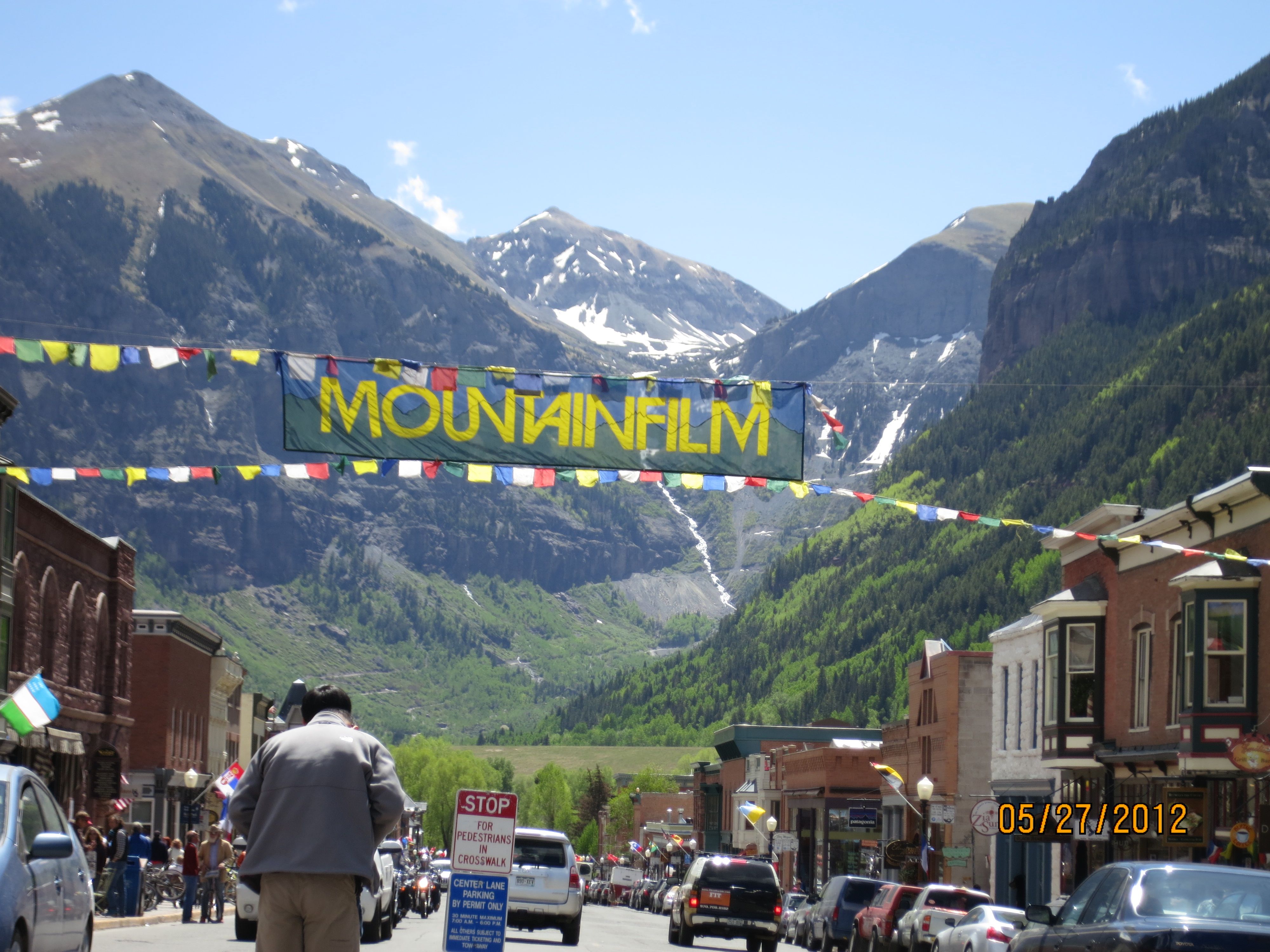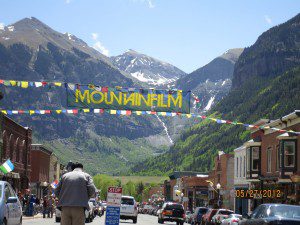
28 May TELLURIDE MOUNTAIN FILM: WRAPPING UP #34
 Season #5 for him and counting. When you’ve given as good as it gets and you know it, it’s time to kick back and enjoy the fruits of your labor. At Mountainfilm 2012, festival director David Holbrooke introduced speakers, greeted the crowds at the various venues with the rakish insouciance of an experienced host welcoming guests to a cocktail party filled with the most interesting people in the world.
Season #5 for him and counting. When you’ve given as good as it gets and you know it, it’s time to kick back and enjoy the fruits of your labor. At Mountainfilm 2012, festival director David Holbrooke introduced speakers, greeted the crowds at the various venues with the rakish insouciance of an experienced host welcoming guests to a cocktail party filled with the most interesting people in the world.
Which they are. On and off the stage. One of those in attendance was Richard Heinberg, senior fellow Post-Carbon Institute and author of “The End of Growth.”
Dial it back to the Moving Mountains Symposium where Heinberg announced that trends around population growth (there are too many of us already and we continue to make babies), energy consumption (fossil fuels are not as readily available as the PR suggests, including coal, and fracking is not just bad for the environment, it is also cost inefficient), and rapid climate change (the science is real, duh) and massive ecological degradation suggest we are at at the cusp of a great turning point in history equal in magnitude to the Industrial Revolution. And here’s the punch line: There will be shocks along the way that will require “social resilience” AT THE LOCAL LEVEL.
Heard that one before? You betcha. And it was at Mountainfilm 2008. Safeguarding nature and ensuring justice, social, political and environmental, Paul Hawken told a packed house at The Palm, must and will come from grassroots initiatives. The glass-is-half-full message: one man can make a difference. We can be the cure. But not if we sit back.
Mountainfilm 2012 was filled with plenty of examples of people who lean way far forward.
We do not pretend to have seen it all – there were close to 70 films at the festival – but we saw enough portraits in courage and conviction to convince us there are plenty of boots on the ground.
Through the lens of George and Beth Gage (“Bidder 70”), we saw Tim DeChristopher in action. His passionate words and his act of peaceful civil disobedience have inspired a generation of young people especially to save their planet from a life-threatening disease. (And DeChristopher’s friends and supporters, Peaceful Uprising, won a $7,000 Moving Mountains Award to support their ongoing efforts.)
(A shining example of DeChristopher’s reach was showcased at Kidz Kino, where one of his young followers, 17-year-old environmental activist Alec Loorz, showed his film “Trust” about the need for youth to challenge adults to change the behavior that is threatening the future of the planet, their future.)
Through Frank Marshall’s “Right to Play,” we got to be inspired by Olympic speed-skating gold medalist, Norwegian Johann Olav Koss, who gave up a career in medicine to ensure that today 700,000 children in 23 countries get a chance to play, something he regards as an inalienable right and a way to grow good citizens of the world. (In one memorable scene, Palestine and Israeli kids play soccer together on the same team. To compete effectively, they must trust their teammates.) Koss is all about changing the world one kid, one soccer ball, at a time and his goal for 2013 is to extend the reach of his nonprofit, Right to Play, to 1 million challenged kids. “Right to Play” won the Mountainfilm’s Audience Choice Award.
We saw another talented young director’s stunning breakout film about one man tireless efforts to save the planet. “Chasing Ice” follows world-renowned photographer-environmental advocate James Balog on a mission to provide irrefutable evidence of climate change through his Extreme Ice Survey project, which documents the disappearance of glaciers. (“Chasing Ice” won the Norman Vaughan Award.)
In the talk that followed the film, Balog commented that “half the casualties in Iraq came from hauling fuel.” Even the generals, the next market he wants to engage in the fight, agree they want to “green things up.”
Balog is not the only example of a major artist using his art to effect positive change. Three other stunning Mountainfilm examples are Ai Weiwei, Sandra Steingraber and Phil Borges.
“Ai Weiwei: Never Sorry” is a film by young director/writer Alison Klayman about the artist-provocateur renowned for giving the finger – literally through his work – to a repressive Chinese government and using social media to egg his millions of followers on to a Jasmine Revolution. Talk about Mountainfilm’s relevance and timing: the exact day of the world premiere Saturday, May 26, articles were posted in the national media, including “The New York Times,” about Ai’s 81 days in captivity. (He was arrested on April 3 and held in a detention center outside of his hometown of Beijing.) Ai’s motto? “Never Retreat. Retweet.” Klayman won Holbrooke’s Director’s Award for her penetrating portrait.
Chandra Chavannes’s “Living Downstream” profiles Sandra Steingraber, a biologist who is also a writer and poet, diagnosed with cancer at age 20. She has been battling the disease for 30 years while trying to connect the dots between the killer that haunts her every day and the probable environmental causes. (Steingraber grew up surrounded by toxic chemical discharge from industrial agriculture.) In the talk that followed the film, Steingraber, who is of German roots also spoke of her campaign against fracking, saying: “We are in the middle of an ecological holocaust and I am not going to be a good German (and play along with the horror).”
She also inveighed against environmental organizations who have sold out to corporate wealth, naming names: The Sierra Club, (which admitted to accepting $26 million from an energy company to support natural gas), the Environmental Defense Fund, the Natural Resource Defense Council. She also gave a shout out to the really good guys who need our help: Environmental Working Group (California) and Erie Rising , a group of Colorado mothers against fracking).
At the Telluride Gallery of Fine Art, the work of photographer Phil Borges in Tibet (book and exhibition) shines a light on a culture under siege.
Are DeChristopher, Koss, Balog, Ai Weiwei, Borges, Steingraber heroes? Not according to Steingraber, who chided Holbrooke when he suggested that is the case, saying: “I am not a hero. I am tired. I am scared. Fear is my dominant (and motivating) emotion.”
The difference between these people and you and me is not a pedestal. It is a sense of urgency. These so-called heroes are just us — only more so.
But what of the difference between us and the truly long-lived and happy planet on the planet? Well, that’s a whole other story, one which Mountainfilm also told very well indeed this year, largely through the person of one extraordinarily charismatic man, Dan Buettner.
Buettner, also a cyclist who completed an Americas trek, a 15,500 mile bike trip from Alaska to Argentina, spoke twice at Mountainfilm, based on the findings in his two books: “The Blue Zone: Lessons for Living Longer from the People Who’ve Lived the Longest” and “Thrive: Finding Happiness in Blues Zones Way.”
Ultimately you have to read the book to discover the ingredients in the KoolAid, but here’s a short summary:
As far as longevity goes, Buettner says it’s “20 percent genes and 80 percent lifestyle.” Folks in Loma Linda, California; Sardinia, Italy; Nicoya, Costa Rica; Ikaria, Greece; and Okinawa, Japan, places old people thrive, are all living in environments that encourage constant and consistent natural movement like walking (no gonzo exercise). People living in these places have the right outlook on life: they live for now (not tomorrow and not to work) and know how to downshift. They eat wisely, which means a plant-based diet supplemented by meat (about three ounces) about five times a month washed down with a glass (or two) of wine. Most important, they value family (and families values their seniors), and share lots of face time with loved ones and close friends. Connection seems to be a sine qua non of longevity.
Happiness? It comes down to having someone to love, something meaningful to do, something else to look forward to in your leisure time, an enjoyment in giving back, oh, and calling your mother. “She cares,” says Buettner.
Yes, as Mountainfilm demonstrated time and again this year as every year, life is fragile. But it is possible to make a difference. Millions of us taking an action can add up to an irresistible force. It is also possible to be happy. Just wake up and smell the cherry blossoms.
(And my special thanks to Lucy Walker for her”There Tsunami and The Cherry Blossom,” one of my all time Mountainfilm favorites and a visual haiku that packs a wallop.)
And no, for all of Mountainfilm’s exposure of the environmental and political issues, it has not forgotten its roots. There is still plenty of well-shot gonzo athletics on display. Lot’s of stuff that causes me to put a hand over my eyes…
Enjoy Clint Viebrock’s video overview.


Sally Anderson
Posted at 09:53h, 29 MayLoved the festival and saw many great films this year including the one’s mentioned here but I’m surprised that less is being said about what was, in my opinion, the most shocking and powerful film in the festival, Baseball in the Time of Cholera! I’ve never been so moved by a film in my life and what is happening in Haiti is a tragedy worth highlighting!